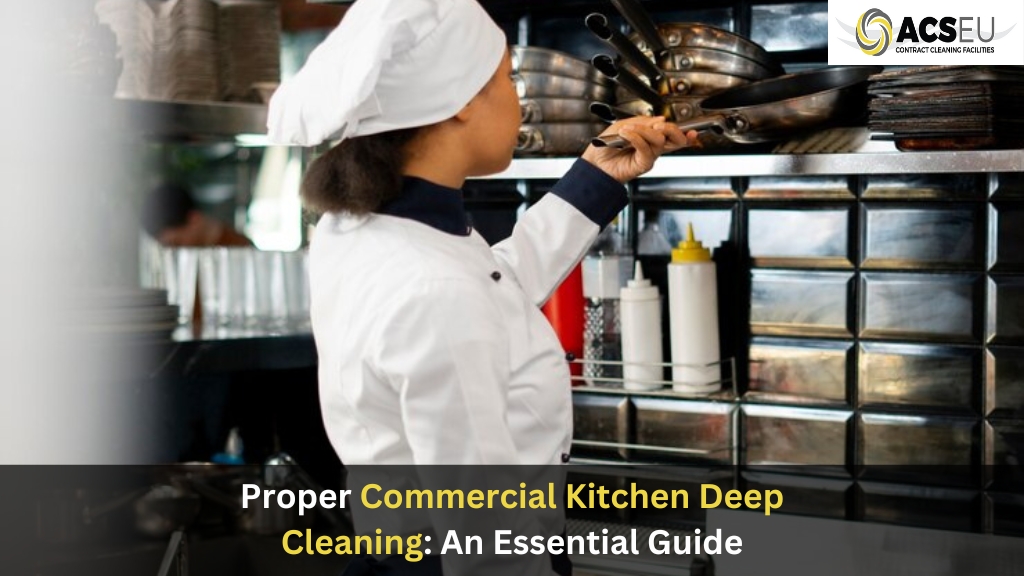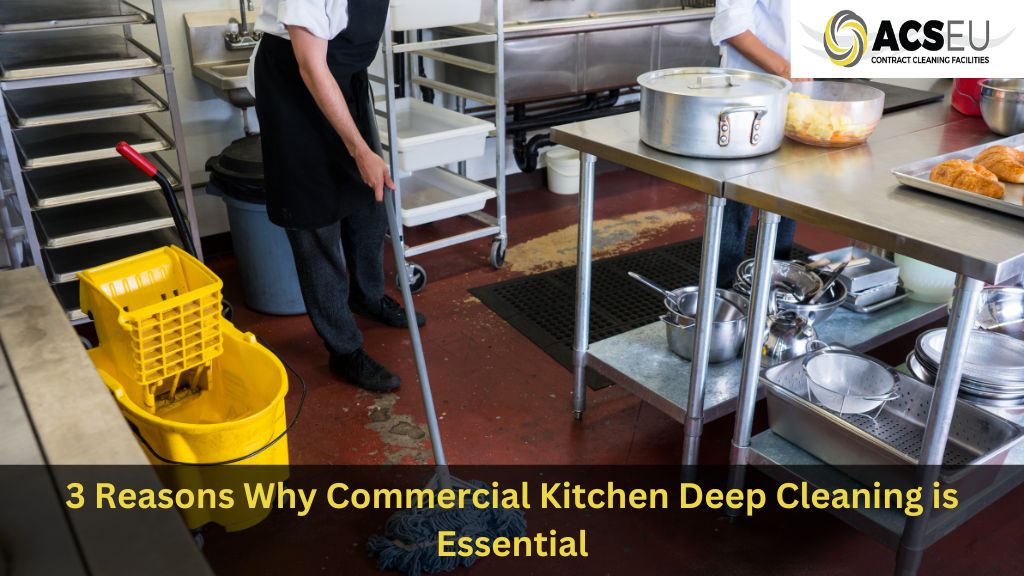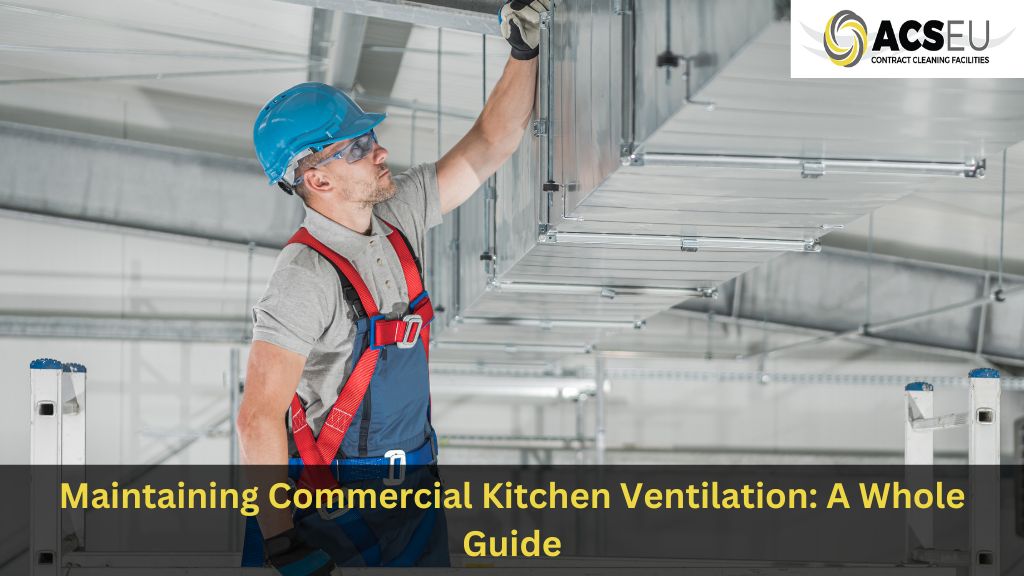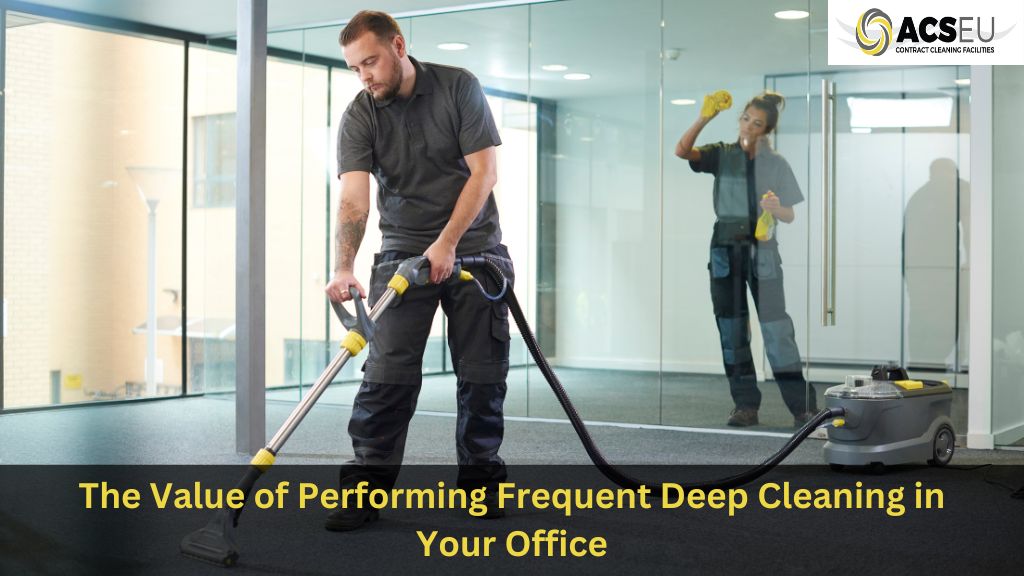In the busiest commercial kitchen, cleanliness is not just about appearances—it is a matter of safety, and compliance. Routine cleaning is great upkeep, but it certainly does not tick all of the health and hygiene boxes. At this point, commercial kitchen deep cleaning services are needed to target grease, grime, and bacteria.
ACSEU Ltd specialise in delivering professional cleaning solutions designed to keep your commercial kitchen operating at peak performance.
What Is Commercial Kitchen Deep Cleaning?
Commercial kitchen deep cleaning is a specialised cleaning service that goes beyond the surface to address build-up. Specifically, in ovens, behind appliances, under workstations, inside ventilation systems, and other neglected areas. It involves detailed sanitisation using advanced tools, industry-grade degreasers, and disinfectants to eliminate harmful pathogens, allergens, and pest attractants.
Unlike daily wipe-downs, deep cleaning reaches the areas where bacteria and grease accumulate silently. Therefore, this poses major risks to food safety and fire prevention.
Why Deep Cleaning Your Kitchen Is Essential
Appearances don’t tell the full story when it comes to food safety. Hidden dirt and bacteria are always a threat, jeopardising customer health and thus brand reputation. So, here is why regular kitchen deep cleaning should be part of your operational routine:
- Compliance with Health Regulations: Regular deep cleaning supports compliance with the Food Safety Act, in addition to HACCP guidelines.
- Minimises Risk of Foodborne Illnesses: Proper sanitisation helps eliminate pathogens like Salmonella, E. coli, and Norovirus.
- Reduces Fire Hazards: Grease build-up in ventilation systems can ignite easily. Best of all, regular exhaust and filter cleaning significantly reduce this risk.
- Improves Working Conditions: A cleaner kitchen leads to better staff morale, safer workflows, and longer-lasting equipment.
- Pest Control: Eliminating hidden food particles and grease deters rodents and insects.
How Often Should Commercial Kitchens Be Deep Cleaned?
The frequency of deep cleaning depends on your kitchen’s size, volume, and the type of food you prepare. However, most health and safety experts recommend scheduling a thorough clean every four to six weeks. Kitchens with high grease output—such as those preparing fried or grilled foods—may need deep cleaning more frequently.
Engaging a professional kitchen cleaner or commercial kitchen cleaning company ensures these schedules are met. In fact, this is without burdening your internal team.
Tools and Products Used by Commercial Kitchen Cleaners
1. Heavy-Duty Degreasers
These chemicals are a staple in any commercial kitchen cleaner’s toolkit specifically designed to break down grease. These options include an array of solvent-based and biodegradable, eco-friendly products.
2. Microfibre Cloths
These reusable cloths trap bacteria and dirt without scratching surfaces. As a result, these are ideal for wiping down stainless-steel equipment.
3. Scrub Brushes and Pads
Different sizes and stiffness levels are used for various surfaces, from tiled walls to tough-to-clean grout.
4. Steam Cleaners
Using high-temperature steam, these machines disinfect surfaces without harsh chemicals. So, this makes them ideal for hard-to-reach areas and sensitive kitchen equipment.
5. Disinfectants and Sanitisers
Professional-grade sanitisers eliminate viruses and bacteria. Above all, certified food-safe disinfectants are essential for maintaining hygiene without risking contamination.
6. Floor Squeegees and Wet Vacs
Used to remove excess water and cleaning solutions from floors to prevent slips and standing water.
Step-by-Step Deep Cleaning Process in a Commercial Kitchen
A professional kitchen cleaner follows a structured method, such as approaching it like this:
Step 1: Preparation
Power down all appliances and unplug where necessary.
Remove food, utensils, and movable equipment from work areas.
Cover sensitive areas or electronics.
Step 2: Degrease and Scrub Surfaces
Apply degreaser to cooking stations, splashbacks, counters, and preparation tables.
Scrub thoroughly to remove stubborn stains and residues.
Step 3: Clean Equipment
Disassemble and soak components like fryer baskets, oven racks, and ventilation filters.
Clean both interiors and exteriors of appliances for instance fryers, ovens, grills, and fridges.
Step 4: Ventilation and Extractor Systems
Remove and clean grease filters.
Degrease hoods, canopies, and internal ductwork to prevent fire hazards and guarantee optimal airflow.
Step 5: Sanitise and Disinfect
Use food-safe sanitisers to treat all surfaces.
Ensure disinfectants remain on surfaces for the required dwell time to be effective.
Step 6: Floor Cleaning
Scrub floors using an appropriate cleaning agent and a mop or scrubber.
Remove excess water with a squeegee and dry thoroughly.
Step 7: Post-Clean Inspection
Conduct a detailed inspection to check for missed spots.
Verify that all equipment is residue-free and thus functional.
Common Mistakes to Avoid
Even diligent teams can fall short if proper practices aren’t followed. So, make sure to avoid all of these pitfalls:
- Using Incorrect Products: Harsh chemicals can damage surfaces or contaminate food-prep areas.
- Neglecting Hard-to-Reach Areas: Behind ovens, under sinks, and inside hoods often go overlooked.
- Skipping Routine Checks: Always perform inspections to ensure a job well done.
- Failing to Document: Record all cleaning activities for compliance and audit purposes.
Partner with ACSEU Ltd for Reliable Kitchen Deep Cleaning
ACSEU are more than just cleaners, in fact we are your partners in professional kitchen maintenance. Above all, our experienced professional kitchen cleaners deliver precise results personalised to your operational demands.
Contact us today to schedule your next deep cleaning session with the most trusted commercial kitchen cleaning company in the region.

 Unit Q, Dodd Lane, Dodd Lane Industrial Estate, Chorley Rd, Westhoughton, BL5 3NA
Unit Q, Dodd Lane, Dodd Lane Industrial Estate, Chorley Rd, Westhoughton, BL5 3NA 




